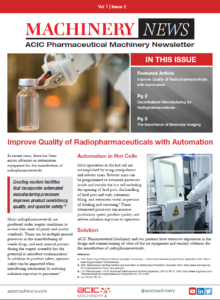Automation in radiopharmaceutical manufacturing is a great thing for all stages of the supply chain. In the manufacturing of radiopharmaceuticals, for example, the automation process can prevent accidents caused by human error. But leakage of contaminants still happens due to various factors that can exist in the process. Precautions can be taken that will help control or mitigate radioactive leakage that can occur.
1. Safe Surfaces
Machinery with areas that materials can easily get caught and exist, such as trims and corners, for example, increase the occurrence of radioactive contamination. The materials forming the surface of machinery, and the casing for the machinery should be easy to decontaminate. During design, non-porous, corrosion-resistant materials should be specified. For example, the use of rounded edges enables the user to easily wash away contaminants from spaces where they might normally get stuck.
2. Air Filtering
Radioactive particles in the air quickly spread through a building, unless precautions are taken. Be proactive by preventing particles from accumulating in the first place. Taking steps to maintain extreme cleanliness at all time, filtering the air, and setting up the ventilation system so that air from a controlled area is not re-circulated back into the building, are all proactive measures that will ensure only the cleanest environment. Integrating HEPA filtration systems contributes to a controlled ISO Class 5 environment.
3. Disposal of Waste
When there is contamination, and it has been dealt with, the radioactive waste (say, from decontaminating a room) needs to be disposed of safely. This will necessarily involve transporting the waste away from where it is. So, when planning an automated environment, think about the path that this waste will travel when leaving the building and ensure that it will not spread contaminants further during the disposal.
4. Double Containment
Double containment should be used as a fail-safe in case the first line of defense fails. Be sure to plan for larger problems that involve more than a single machine or area. Consider the spread of contamination in the event of a large accident – don’t just think about the machine and its immediate vicinity, but about where radioactive contaminants might spread through contact, waste disposal, or airflow. For example, if the container around the machine is negative pressure, and springs a leak, radioactive particles in the air will not spread. So far so good, but if there is a larger accident, this may not be enough, and contaminants will spread from the room throughout the building. By making the entire room negative pressure, you can contain more serious leaks with relative ease.
In the manufacturing process that involves radioactive elements, a thorough consideration beyond the obvious decontamination plan and process is not just smart but should be mandatory. Steps can be taken in stages, such as in the design of the hot-cell automation process. Early design considerations will not just save time and money, but will also create a safer environment and a more efficient way of dealing with potential harm.
If you have any questions regarding automation in radiopharmaceutical manufacturing, please contact us.


